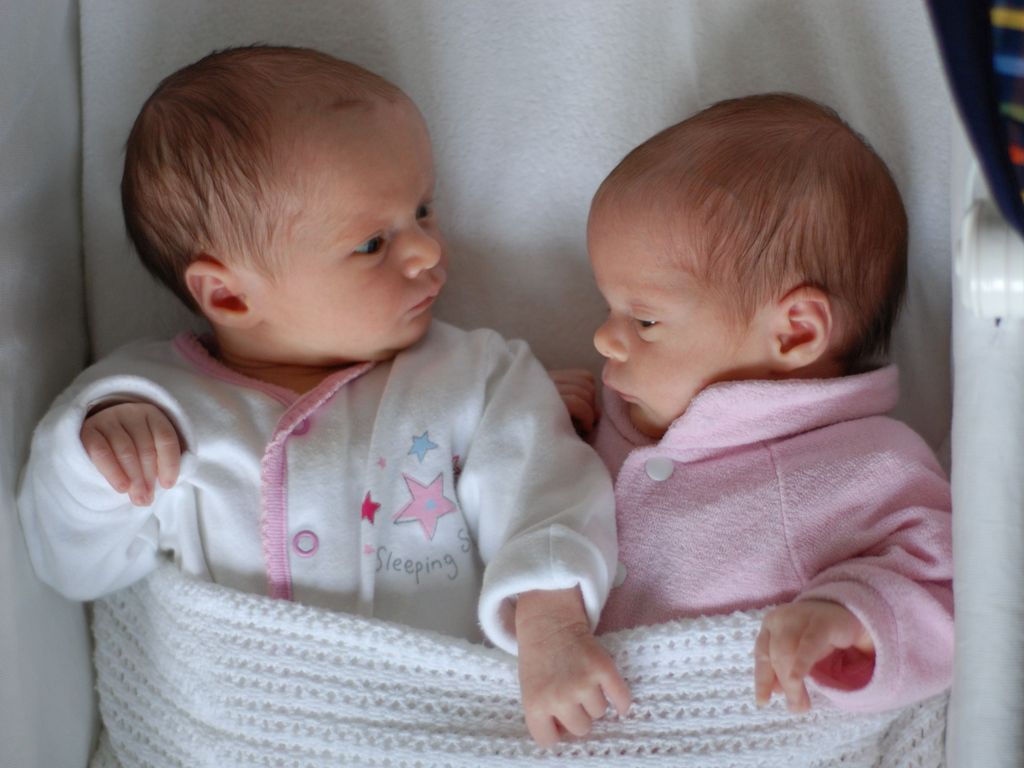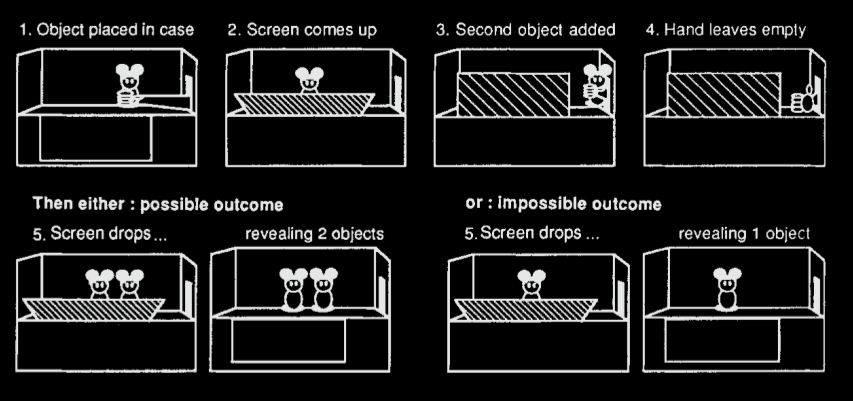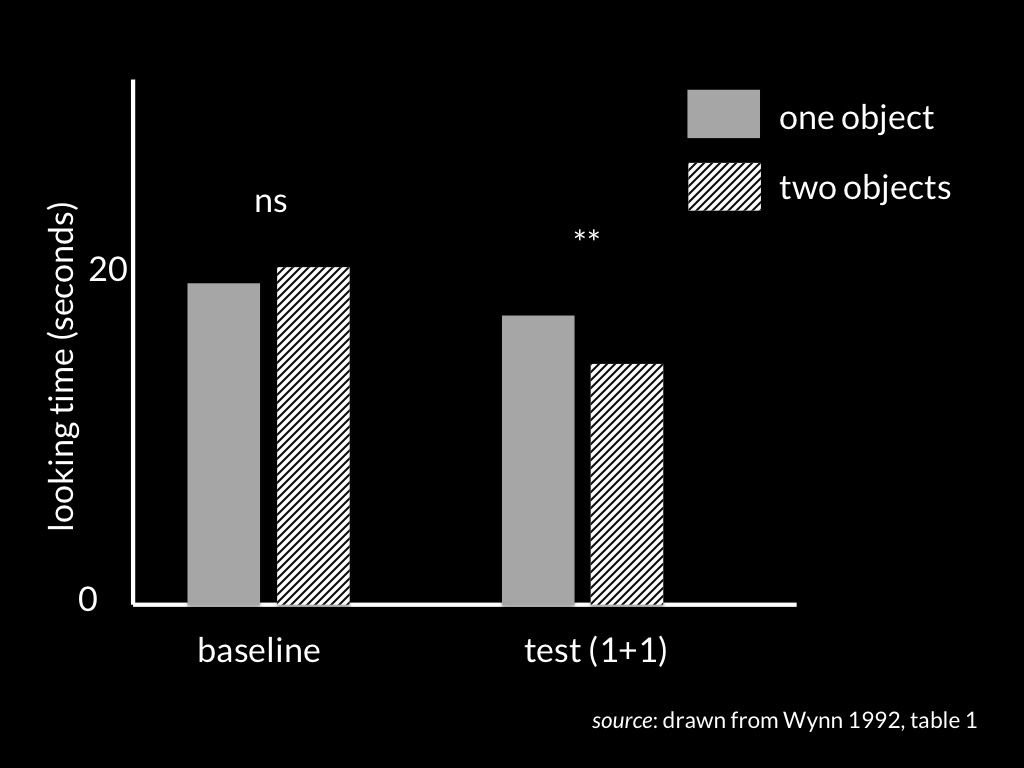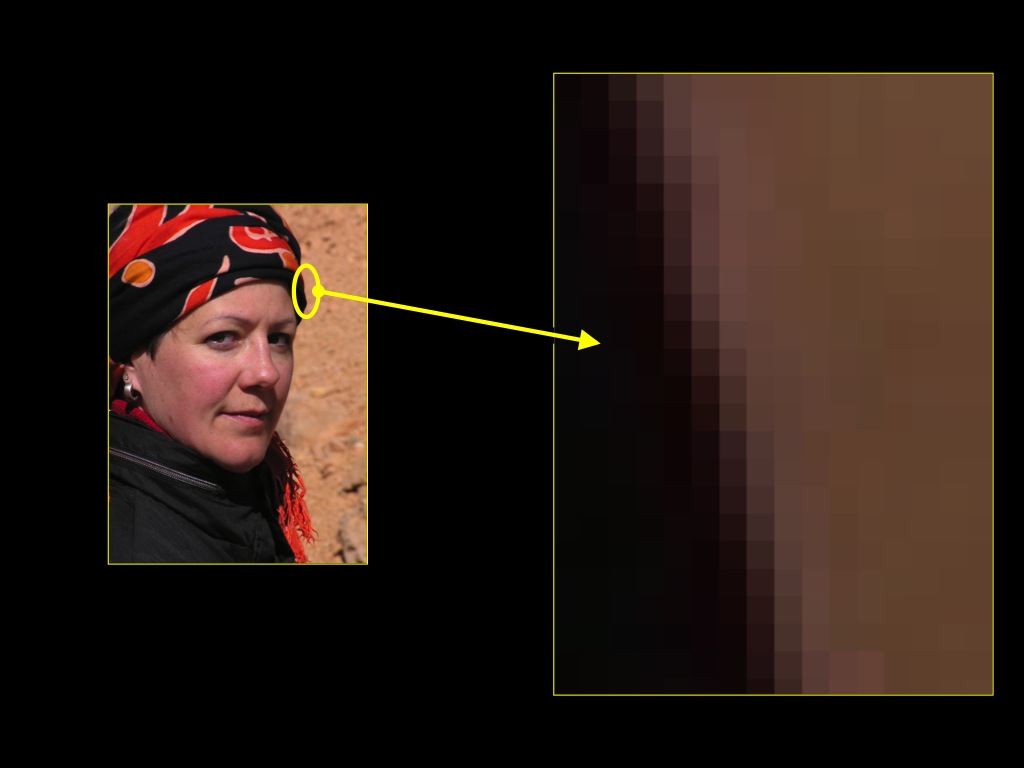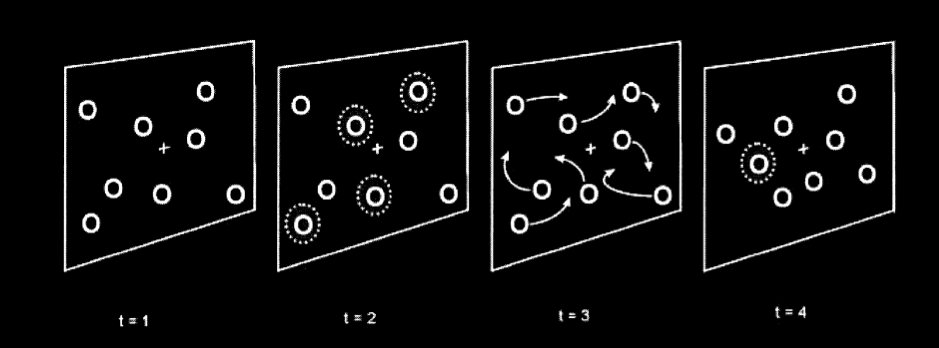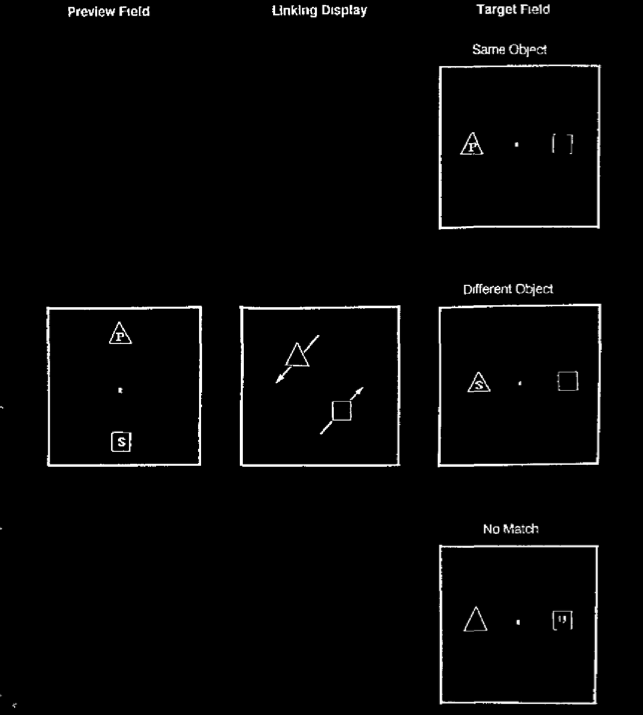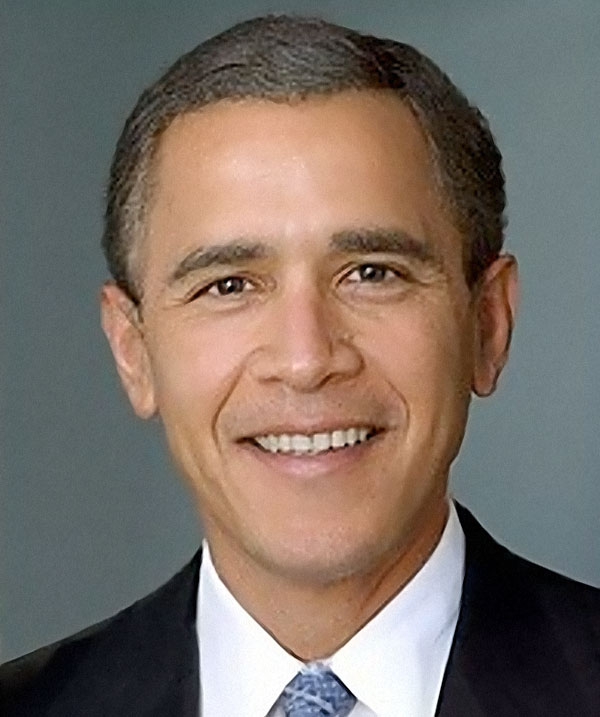In what follows I will take it for granted that, in adult humans,
there is a system of object indexes which enables them to track
potentially moving objects in ongoing actions such as visually tracking or
reaching for objects, and which influences how their attention is allocated
\citep{flombaum:2008_attentional}.
object indexes / files in adults and infants ...
- guide ongoing action (e.g. visual tracking, reaching)
- influence how attention is allocated
- can conflict with beliefs and knowledge states
This system of object indexes
does not involve belief or knowledge
and may assign indexes to objects in ways that are inconsistent with
a subject’s beliefs about the identities of objects
\citep[e.g.][]{Mitroff:2004pc, mitroff:2007_space}
- have behavioural and neural markers
We have observed one behavioural marker of object
indexes, namely the object-specific preview benefit.
There are also neural markers of object indexes.
That is, in adults there is a pattern of brain activity which appears to be
characteristic of processes involved in maintaining an object index
for an object that is briefly hidden from view.
- are subject to signature limits
The system of object indexes is also subject to signature limits.
In general, a \emph{signature limit of a system} is a pattern of behaviour the system exhibits which is both defective given what the system is for and peculiar to that system.
One signature limit of a system of object indexes is that featural information sometimes fails to influence how objects are assigned in ways that seem quite dramatic.
Let me illustrate ...
In this scenario,
a patterned square disappears behind the barrier; later a plain black ring emerges.
If you consider speed and direction only, these movements are consistent with there being just one object.
But given the distinct shapes and textures of these things, it seems all but certain that there must be two objects.
Yet in many cases these two objects will be assigned the same object index \citep{flombaum:2006_temporal,mitroff:2007_space}.
So one signature limit of systems of object indexes is that information about speed and distance can override information about shape and texture.
- sometimes survive occlusion
As the findings I just describes imply,
object indexes can survive brief occlusion.
That is, an object index
can remain attached to an object even if that
object is briefly occluded by a screen.
(Sameness of object index may be detected by the presence of an
object-specific preview benefit).
To clarify terminology,
I should say that whereas I’m talking about object indexes,
researchers more typically interpret this research in terms of object
files.
I’m sticking to object indexes rather than object files for
reasons of simplicity and caution.
If you believe in object files then you can interpret what I’m saying
as referring to object files.
And if you have doubts about object files, you might still have reason
to accept that a system of object indexes exists.
So far I have been talking about object indexes in adult humans.
But our interest in object indexes stems from a Hypothesis about
four-month-old infants’
abilities to track briefly occluded objects.
According to this hypothesis, these abilities depend on a system of
object indexes like that which underpins multiple object tracking or
object-specific preview benefits
\citep{Leslie:1998zk,Scholl:1999mi,Carey:2001ue,scholl:2007_objecta}.
What makes this hypothesis attractive?
Hypothesis:
Tracking occluded objects depends on object indexes.
(And reaching for endarkened objects depends on motor representations of objects.)
Several considerations favour the hypothesis about object indexes ...
One reason the hypothesis seems like a good bet is that object
indexes are the kind of thing which could in principle explain
infants’ abilities to track unperceived objects because object indexes
can, within limits, survive occlusion.
If we consider six-month-olds, we can also find behavioural markers
of object indexes in infants \citep{richardson:2004_multimodal} ...
... and there are is also a report of neural markers too \citep{kaufman:2005_oscillatory}.
(\citet{kaufman:2005_oscillatory} measured brain activity in
six-month-olds infants as they observed a display typical of an object
disappearing behind a barrier.
They found the pattern of brain activity characteristic of maintaining
an object index.
This suggests that in infants, as in adults, object indexes can attach
to objects that are briefly unperceived.)
The evidence we have so far gets us as far as saying, in effect, that someone capable of committing a murder was in the right place at the right time.
Can we go beyond such circumstantial evidence?
The key to doing this is to exploit signature limits.
\citet{carey:2009_origin} argues that what I am calling the signature
limits of object indexes in adults are related to signature limits on
infants’ abilities to track briefly occluded objects.
To illustrate, a moment ago I mentioned that one signature limit of
object indexes is that featural information sometimes fails to influence how objects are assigned in ways that seem quite dramatic.
There is evidence that, similarly, even 10-month-olds will sometimes
ignore featural information in tracking occluded objects
\citep{xu:1996_infants}.%
\footnote{
This argument is complicated by evidence that infants around 10 months of age do not always fail to use featural information appropriately in representing objects as persisting \citep{wilcox:2002_infants}.
In fact \citet{mccurry:2009_beyond} report evidence that even five-month-olds can make use of featural information in representing objects as persisting \citep[see also][]{wilcox:1999_object}.
%they use a fringe and a reaching paradigm. NB the reaching is a problem for the simple interpretation of looking vs reaching!
Likewise, object indexes are not always updated in ways that amount to ignoring featural information \citep{hollingworth:2009_object,moore:2010_features}.
It remains to be seen whether there is really an exact match between the signature limit on object indexes and the signature limit on four-month-olds’ abilities to represent objects as persisting.
The hypothesis under consideration---that infants’ abilities
to track briefly occluded objects depend on a system of
object indexes like that which underpins multiple object tracking or
object-specific preview benefits---is a bet on the match being exact.
}
Here are the results.
The central column shows that infants looked longer when they saw
two objects at test rather than when they saw a single object.
This is not different from how they performed in a base line condition
when the information about number was not present.
And it is different from how they performed in the ‘spatiotemporal
condition’ in which the two objects were at simultaneously
visible at one point before the test phase.
While I wouldn’t want to suggest that the evidence on
siganture limits is
decisive, I think it does motivate considering the hypothesis and its
consequences.
In what follows I will assume the hypothesis is true:
infants’ abilities
to track briefly occluded objects depend on a system of
object indexes.
The hypothesis has an advantage which I don’t think is widely
recognised.
This is that object indexes are independent of beliefs and knowledge
states.
Having an object index pointing to a location is not the same thing
as believing that an object is there.
And nor is having an object index pointing to a series of locations over time
is the same thing as believing or knowing that these locations
are points on the path of a single object.
Further, the assignments of object indexes do not invariably give rise
to beliefs and need not match your beliefs.
To emphasise this point, consider once more this scenario
in which a patterned square disappears behind the barrier; later a
plain black ring emerges. You probably don't believe that they are
the same object, but they probably do get assigned the same object index.
Your beliefs and assignments of object indexes are inconsistent in this
sense: the world cannot be such that both are correct.
So assignments of object indexes can conflict with beliefs.
Why is this an advantage?
At the start of this talk I emphasised the variety of evidence
which shows that infants, from four months of age or earlier,
can track briefly occluded objects.
However there is also a substantial body of evidence which suggests that
infants of this age, and even infants who are several months older,
systematically fail to search for briefly occluded objects.
To illustrate, consider an ingenious experiment by \citet{Shinskey:2001fk}.
There was an opaque screen that could rotate between lying flat on the ground and being raised to conceal a toy behind it.
\citeauthor{Shinskey:2001fk} also used a second piece of apparatus just like the first except that the screen was transparent rather than opaque.
They reasoned that infants would quite often pull the screen forwards just for fun, regardless of what is behind it.
However, they also guessed that when infants know there is an interesting toy behind the screen, then they will pull it forwards more often than when they know that there is nothing behind the screen.
This is just what happened when infants were presented with the apparatus involving a transparent screen:
they sometimes pulled the screen forwards when there was no toy behind it, but they pulled it forwards significantly more often when the toy was behind it.
What happened when infants were presented with the opaque screen?
Here infants pulled the screen forwards no more often when they had observed a toy being placed behind it then when they had observed that there was nothing behind it.
This is evidence that seven-month-old infants do not know that a toy they have very recently seen hidden behind a screen is behind the screen.
After all, since knowledge guides action we would expect infants who know that a toy is behind an opaque screen to pull the screen forward more often than infants who know there is nothing behind the screen, just as they do when the screen is transparent.
More than two decades of research strongly supports the view that
infants fail to search for objects hidden behind barriers or screens
until around eight months of age \citep[p.\ 202]{Meltzoff:1998wp} or
maybe even later \citep{moore:2008_factors}.
Researchers have carefully controlled for the possibility that infants’
failures to search are due to extraneous demands on memory or the
control of action.
We must therefore conclude, I think, that four- and five-month-old
infants do not have beliefs about the locations of briefly occluded
objects.
It is the absence of belief that explains their failures to search.
Why do 5 month olds fail to manifest their ability to track briefly
occluded objects by initiating searches for them after they have been
fully occluded? Because object indexes are independent of beliefs
and do not by themselves support the initiation of action.
Further, I guess that occlusion interferes
with motor representations of objects in infants because occlusion
involves two objects, one in front of the other.
Why do 5 month olds fail to manifest their ability to track endarkened
objects on v-of-e experiments? Because endarkening interferes with object
indexes; and although endarkening does not eliminate motor representations,
I guess that these representations do not generally influence looking times.
Why do infants succeed in searching for momentarily endarkend objects?
Because they can represent objects motorically, and endarkening does
not immediately interfere with such representations.
Why do infants manifest an ability to track briefly occluded objects on
violoation-of-expectations tasks?
Ah ... just here we face a significant challenge ...
As I said at the start of this talk, infants’ abilities to track briefly
occluded objects are manifested in several different ways.
They are manifested in (iii) anticipatory looking, (ii) reactions
indicating the violation of an expectation, and (i) dishabituation
indicating interest in certain stimuli.
Can all of these behaviours be explained merely by invoking object
indexes?
This is an important question for me so I want to pause to emphasise it.
This question is, What can the operations of a system of
object indexes explain?
The primary functions of object indexes include influencing the allocation
of attention and perhaps guiding ongoing action.
If this is right, it may be possible to explain anticipatory looking
directly by appeal to the operations of object indexes.
But the operations of object indexes cannot directly explain differences
in how novel things are to an infant.
And nor can the operations of object indexes directly explain why infants
look longer at stimuli involving discrepancies in the physical behaviour
of objects.
To illustrate this point, recall this famous violation-of-expectations
experiment by \citet{wynn:1992_addition}.
Her subjects were five-month-olds.
We know that infants are likely to maintain object indexes for the two
mice while they are occluded.
Accordingly, when the screen drops in the condition labelled
‘impossible outcome’, there is an interruption to the normal
operation of object indexes: infants have assigned two object indexes
but there is only one object.
But why does this cause infants to look longer at in the
‘impossible outcome’ condition than in the ‘possible outcome’ condition?
How does a difference in operations involving object indexes result
in a difference in looking times?
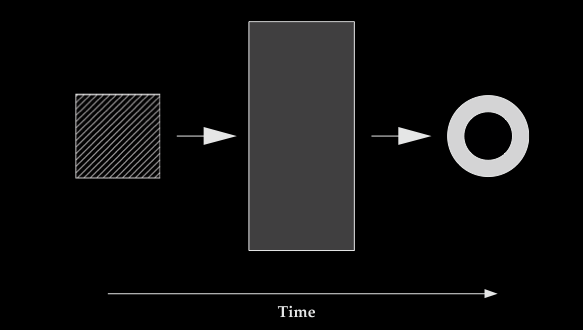
Scholl 2007, figure 4
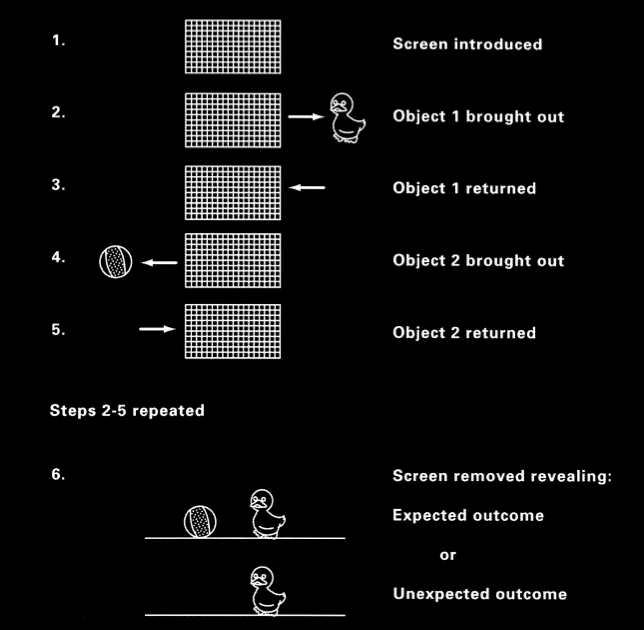
Carey and Xu 2001, figure 3
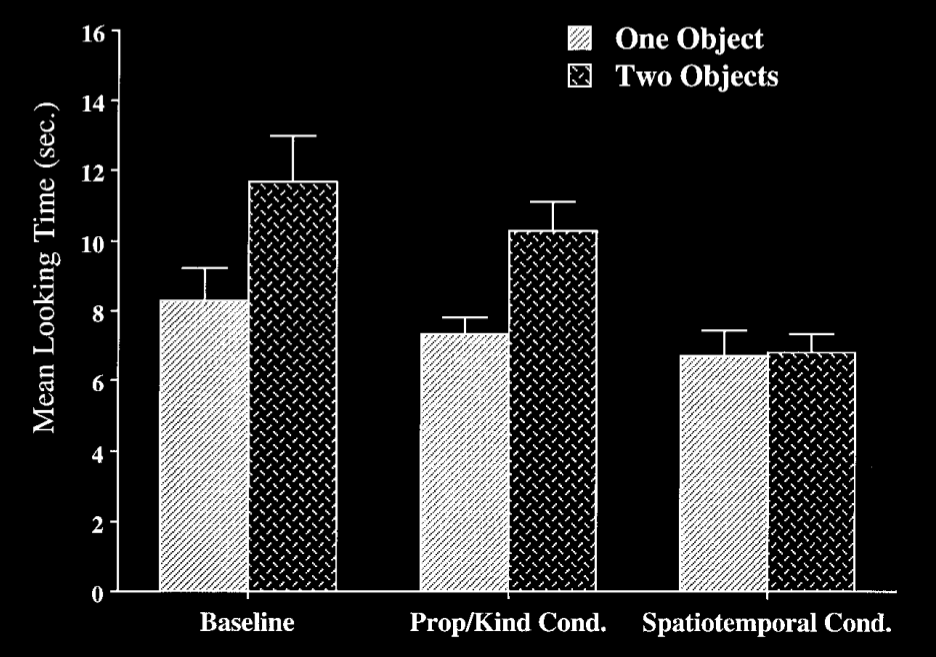
Xu and Carey 1996, figure 4
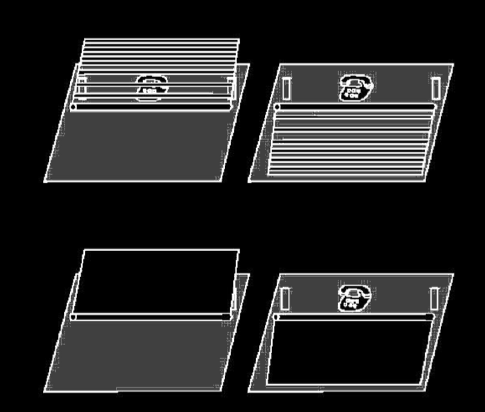
Shinskey & Munakata 2001, figure 1
| | occlusion | endarkening |
| violation-of-expectations | ✔ | ✘ |
| manual search | ✘ | ✔ |
Charles & Rivera (2009)
What can object indexes explain?
